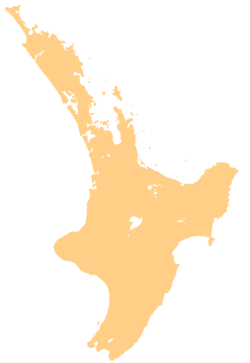Waipiro Bay facts for kids
Quick facts for kids
Waipiro Bay
Waipiro (Māori)
|
|
|---|---|
| Country | New Zealand |
| Region | Gisborne Region |
| Ward | Waiapu |
| Electorate | East Coast |
| Population | |
| • Estimate
(2011)
|
96 (20 families) |
| Time zone | UTC+12 (NZST) |
| • Summer (DST) | UTC+13 (NZDT) |
| Postcode |
4079
|
| Area code(s) | 06 |
Waipiro Bay is a small town located right on the coast in the Gisborne Region of New Zealand. It's on the East Coast of the North Island. The name "Waipiro" also refers to the bay itself. Chief Paoa gave it this name, which means "putrid water." This name comes from the area's natural sulfur smell.
Waipiro Bay is part of the Waiapu ward. Other nearby towns include Te Puia Springs, Tokomaru Bay, and Ruatoria. It is about 15 kilometers (9 miles) south of Ruatoria. It's also 77 kilometers (48 miles) northeast of Gisborne. The East Cape Lighthouse, the easternmost point of mainland New Zealand, is 41 kilometers (25 miles) southwest. If you travel by road, it's 103 kilometers (64 miles) from Gisborne. It's also 231 kilometers (144 miles) from Ōpōtiki. The Gisborne District Council manages Waipiro Bay. It is in the East Coast electorate, which is an area represented by a Member of Parliament.
In the early 1900s, Waipiro Bay was a very busy place. It was the largest town on the East Coast. At its busiest, up to 10,000 people lived there. But a new road was built in the late 1920s that went around the bay. This made the town much smaller. By 2011, only about 96 people lived there. That's about 20 families.
During certain times of the year, the Gisborne District Council allows "freedom camping" in some parts of the bay. This means you can camp for free. The bay is a great spot for surfing, fishing, and diving. Te Ara - the Encyclopedia of New Zealand describes Waipiro Bay as "one of the most scenic of the coast localities." This means it's one of the most beautiful places along the coast.
Contents
Waipiro Bay's Past
Early Days
The Māori had a settlement at Waipiro Bay long ago. They were hunting whales from this area in the mid-1800s.
For a while, a nearby place called Akuaku was the main center. But by the late 1800s, Waipiro Bay became the hub for farming. A post office opened in 1885. From the 1890s, wool was shipped out of the bay. Livestock, supplies, and equipment were shipped in. This was often for J. N. Williams's farms. Waipiro Bay does not have a deep harbor. So, goods and people had to be moved between the shore and ships. This was done using special boats like surfboats, lighters, or rafts.
The 20th Century Boom and Change
In the early 1900s, a road was built to Waipiro Bay. Akuaku did not have a road, so people started moving to Waipiro Bay. It became the new popular place. Eventually, the main highway north went through Waipiro Bay. This made it a very important link between Gisborne and the rest of the East Coast.
Between the 1900s and 1920s, Waipiro Bay grew a lot. It became the biggest town on the East Coast. Its population reached up to 10,000 people. As the town grew, it had many important buildings. These included the Waiapu County Council offices, a police station, and a courthouse. There was also a school, two hotels, and a general store. Many other shops opened too. Sir Robert Kerridge, who started Regent Cinemas, opened his first movie theater here. A hospital for new mothers was also set up in a house.
According to Te Ara - the Encyclopedia of New Zealand, a new road was built in the late 1920s. This road went between Te Puia Springs and Kopuaroa. It bypassed Waipiro Bay. However, a former resident named Paora Kahu Carter remembered it differently. She said the road was built after she moved there in 1940. She remembered a busy town with many services. These included a blacksmith, a movie theater, and a police station. There was also a billiards bar, a hotel, a library, a bakery, and a post office. Two shops and the Waipiro Trading Company were also there.
No matter when the road was built, it changed the town a lot. Road transport became more common than sea transport. Waipiro Bay became cut off. Shops and services moved to Te Puia Springs. By 2011, Waipiro Bay's population was only about 1% of what it was at its busiest.
Marae: Community Meeting Places
The local marae is called Iritekura Marae. A marae is a special meeting place for Māori communities. It is very important to the people of Waipiro Bay. It also has an old church. Iritekura Marae is a meeting place for the Ngāti Porou hapū (a smaller group within a tribe) called Te Whānau a Iritekura. It has a meeting house with the same name.
Two other old Ngāti Porou marae are north of Waipiro Bay village. Taharora Marae and its meeting house are for the hapū of Ngāi Taharora. Kie Kie Marae and Hau meeting house are for Te Whānau a Rākairoa and Te Whānau a Te Haemata.
In October 2020, the New Zealand Government helped these marae. They gave money to upgrade Iritekura, Taharora, and 27 other Ngāti Porou marae. This funding was expected to create many jobs.
Learning in Waipiro Bay
Waipiro Bay has a local primary school. It is called Te Kura Kaupapa Maori o Waipiro. This is a Māori language immersion school. This means students learn mostly in the Māori language. It is for both boys and girls. Students from Years 1 to 8 attend this school. In April 2012, the school had ten students.


